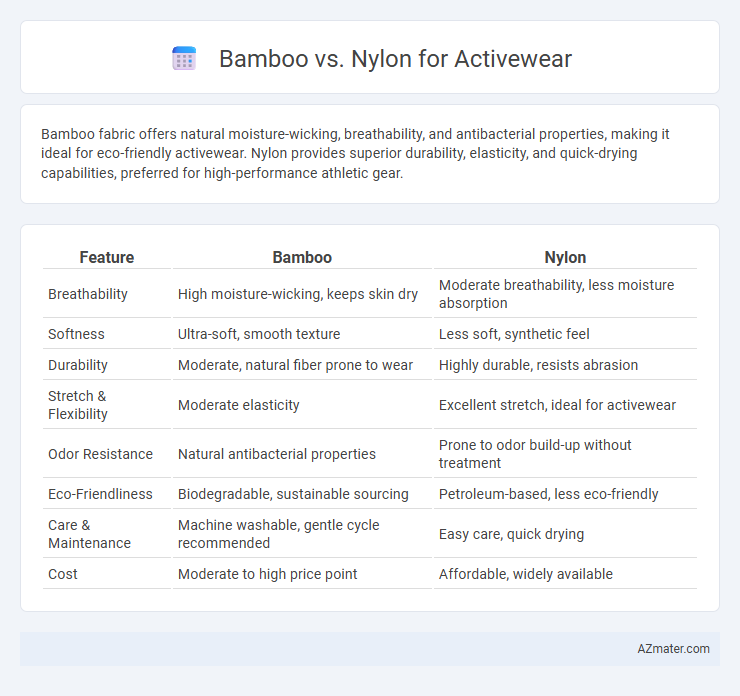Bamboo fabric offers natural moisture-wicking, breathability, and antibacterial properties, making it ideal for eco-friendly activewear. Nylon provides superior durability, elasticity, and quick-drying capabilities, preferred for high-performance athletic gear.
Table of Comparison
| Feature | Bamboo | Nylon |
|---|---|---|
| Breathability | High moisture-wicking, keeps skin dry | Moderate breathability, less moisture absorption |
| Softness | Ultra-soft, smooth texture | Less soft, synthetic feel |
| Durability | Moderate, natural fiber prone to wear | Highly durable, resists abrasion |
| Stretch & Flexibility | Moderate elasticity | Excellent stretch, ideal for activewear |
| Odor Resistance | Natural antibacterial properties | Prone to odor build-up without treatment |
| Eco-Friendliness | Biodegradable, sustainable sourcing | Petroleum-based, less eco-friendly |
| Care & Maintenance | Machine washable, gentle cycle recommended | Easy care, quick drying |
| Cost | Moderate to high price point | Affordable, widely available |
Introduction to Bamboo and Nylon in Activewear
Bamboo fibers in activewear offer natural moisture-wicking, breathability, and antibacterial properties, making them ideal for sweaty workouts and sensitive skin. Nylon, a synthetic polymer, provides durability, elasticity, and quick-drying capabilities, supporting high-performance and long-lasting wear. Both materials cater to different active lifestyle needs, with bamboo emphasizing eco-friendliness and comfort, while nylon prioritizes strength and resilience.
Material Origins: How Bamboo and Nylon are Made
Bamboo fabric is derived from the pulp of bamboo grass, which undergoes a chemical or mechanical process to transform the raw fibers into a soft, breathable textile, making it a sustainable and eco-friendly option. Nylon is a synthetic polymer created through the polymerization of petrochemicals, primarily derived from crude oil, resulting in a durable and stretchable fabric commonly used in activewear for its moisture-wicking properties. The natural origin of bamboo contrasts with nylon's petroleum-based production, impacting environmental considerations and fabric performance in activewear applications.
Sustainability and Environmental Impact
Bamboo fibers offer superior sustainability for activewear due to their rapid growth and minimal need for pesticides, significantly reducing environmental impact compared to nylon, which is synthetic and derived from petroleum. Bamboo is biodegradable and requires less water during cultivation, making it an eco-friendly choice, while nylon production releases greenhouse gases and microplastics harmful to marine ecosystems. Choosing bamboo activewear supports a circular economy by promoting renewable resources and reducing carbon footprints relative to traditional nylon fabrics.
Breathability and Moisture-Wicking Properties
Bamboo fabric offers superior breathability due to its natural micro-gaps that enhance airflow, making it ideal for activewear designed for intense workouts or hot climates. Nylon, while durable and lightweight, tends to retain heat more than bamboo but excels in moisture-wicking by rapidly pulling sweat away from the skin to the outer surface for quick evaporation. Choosing between bamboo and nylon for activewear depends on prioritizing natural breathability and softness versus high-performance moisture management and durability.
Comfort and Skin Sensitivity
Bamboo fabric offers superior softness and breathability compared to nylon, making it ideal for activewear designed for sensitive skin. Its natural antibacterial and moisture-wicking properties reduce irritation and keep skin dry during intense workouts. Nylon, while durable and quick-drying, may cause discomfort or allergic reactions for those with sensitive skin due to its synthetic composition.
Durability and Longevity
Nylon activewear is known for its exceptional durability, resisting wear and tear through repeated use and washing, making it ideal for high-intensity activities. Bamboo fabric offers natural antimicrobial properties and breathability but tends to degrade faster than nylon when exposed to frequent laundering and abrasive conditions. Choosing nylon ensures longer-lasting performance gear, while bamboo prioritizes comfort with moderate durability.
Odor Resistance and Bacterial Control
Bamboo fabric naturally offers superior odor resistance and bacterial control due to its inherent antimicrobial properties and moisture-wicking abilities, making it ideal for activewear. Nylon, while durable and quick-drying, tends to retain odors more easily because it lacks these natural antimicrobial qualities. Activewear made from bamboo provides prolonged freshness during intense workouts by effectively reducing bacterial growth and odor buildup.
Style, Fit, and Performance
Bamboo activewear offers a distinctive style with its natural sheen and soft texture, while nylon provides a sleek, smooth appearance favored for a modern athletic look. Fit-wise, bamboo fabrics typically offer greater breathability and moisture-wicking properties, enhancing comfort during intense workouts, whereas nylon excels in durability and stretch, maintaining shape and support for dynamic movements. Performance in activewear hinges on moisture management and flexibility; bamboo outperforms in antibacterial and hypoallergenic benefits, while nylon is superior in quick-drying capabilities and abrasion resistance.
Maintenance and Care Requirements
Bamboo activewear requires gentle washing in cold water and air drying to maintain its natural softness and antimicrobial properties, avoiding bleach and high heat that can degrade the fibers. Nylon activewear is more durable with easy maintenance, allowing machine washing and quick drying, but prolonged exposure to high temperatures and harsh detergents can weaken the fabric and reduce elasticity. Proper care extends the lifespan of both materials while preserving performance features such as moisture-wicking and breathability.
Cost Comparison and Value for Money
Bamboo activewear typically costs more upfront due to sustainable production processes, but offers superior breathability, moisture-wicking, and natural antibacterial properties that extend garment life and reduce odor buildup. Nylon is generally more affordable and highly durable, making it a cost-effective choice for budget-conscious consumers prioritizing longevity and stretch. Considering long-term wear, bamboo provides better value for money through comfort and eco-friendliness, while nylon delivers strong performance at a lower initial price point.

Infographic: Bamboo vs Nylon for Activewear
 azmater.com
azmater.com